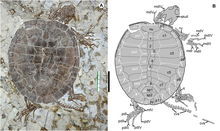| Sinemydidae Temporal range: | |
|---|---|
 | |
| Jeholochelys | |
 | |
| Ordosemys | |
| Scientific classification | |
| Domain: | Eukaryota |
| Kingdom: | Animalia |
| Phylum: | Chordata |
| Class: | Reptilia |
| Clade: | Pantestudines |
| Clade: | Testudinata |
| Clade: | Perichelydia |
| Family: | † Sinemydidae Yeh, 1963 |
| Genera | |
See text | |
Sinemydidae is an extinct family of turtles from the Jurassic and Cretaceous of East Asia. [1] Their exact position is engimatic, they have alternatively been considered stem-group cryptodires, but also "crownward stem-turtles" alongside Macrobaenidae, Paracryptodira, Xinjiangchelyidae, Thalassochelydia and Sandownidae outside of crown Testudines.